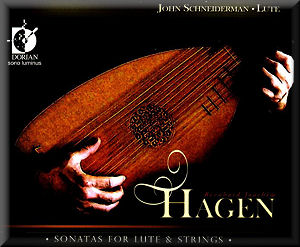 |
 |
|


alternatively
CD: MDT
|
Bernhard Joachim
HAGEN (1720 - 1787)
Sonatas for Lute and Strings
Sonata in F [13:57]
Sonata in E flat [12:27]
Sonata in C [10:09]
Sonata in B flat [10:08]
Sonata in a minor [12:36]
Sonata in A 'Pastorella' [13:17]
 John Schneiderman (lute), Elizabeth Blumenstock (violin), William
Skeen (cello)
John Schneiderman (lute), Elizabeth Blumenstock (violin), William
Skeen (cello)
rec. no date given, Baker Estate, Pebble Beach, California, USA.
DDD
 DORIAN DSL-90907 [72:38]
DORIAN DSL-90907 [72:38] 
|
|
|
The life and oeuvre of Bernhard Joachim Hagen is indicative
of the state of the lute in Germany from the mid-18th century
onwards. It was still popular among amateurs: the catalogues
of the music publisher Breitkopf of the 1760s contain a large
number of compositions for or with lute. But most professional
players also played other instruments, since the instrument
was in decline at least among court orchestras. Bernhard Joachim
Hagen is just one example.
Not that much is known about Hagen. The main data come from
an entry in the Historisch-biographisches Lexicon der Tonkünstler,
published in 1790-92 by the German scholar Ernst Ludwig Gerber.
Thanks to him the Christian names of Hagen are mostly given
in the wrong order: Joachim Bernhard. But his Sonatina per
il Liuto per B.J. Hagen shows that his proper name was Bernhard
Joachim. He learned to play the lute and the violin at an early
age, and may have been a pupil of his older brother Peter Albrecht,
who had been a pupil of Geminiani in London and was an organist
in Rotterdam in the Netherlands from 1731 until his death in
1777.
Bernhard Joachim's first position was at the court of Bayreuth
where he was appointed, not as a lutenist, but as a violinist.
Even so, this was one of the few courts where the lute was still
in demand. That was mainly due to Margravine Wilhelmine, the
younger sister of Frederick the Great of Prussia, who married
Frederick who was to become Margrave of Brandenburg-Bayreuth
in 1735. Wilhelmine played the harpsichord and developed a passion
for the lute. When she heard Silvius Leopold Weiss play in 1728
it made a great impression on her. At the time very little was
going on when she arrived in Bayreuth. She immediately appointed
architects to build a palace, and in 1748 a new opera house
was opened which was one of the largest in Europe.
She also attracted musicians in order to establish a court orchestra.
By 1738 the orchestra consisted of 17 musicians, among them
the brothers Jakob Friedrich and Johann Stephan Kleinknecht,
both flautists, the violinist Johann Daniel Lenthardt and the
lutist Adam Falckenhagen. The Kapellmeister was Johann
Pfeiffer, who was appointed in 1734. In 1737 Hagen joined the
court orchestra as violinist. In this capacity he must have
been quite skilled, as he regularly acted as a substitute for
Pfeiffer. It seems he never acted as lutenist at the court:
when Falckenhagen died in 1754 he was not succeeded by Hagen,
but by Paul Charles Durant about whom hardly anything is known.
In 1758 Wilhelmine died at the age of 49. The opera house was
sold, and musical activities were greatly diminished. The orchestra
wasn't disbanded, though: when Pfeiffer died in 1761 Jakob Friedrich
Kleinknecht succeeded him as Kapellmeister. But when
in 1763 the Margrave died without an heir the House of Brandenburg-Bayreuth
merged with the House of Brandenburg-Ansbach. The court moved
to Ansbach in 1769, and here Hagen remained active as violinist
until his death.
Hagen's whole oeuvre centres around the lute, and is preserved
in one source, a collection of manuscripts which is now in the
Augsburg State Library. These comprise twelve lute sonatas,
two lute concertos, a duo for two lutes, a duo for lute and
violin, a number of arrangements for the lute of pieces by other
composers, and the six trios recorded here. They are all in
three movements, in the order fast-slow-fast. The two treble
parts are more or less independent. Motifs in one are often
imitated in the other. There are also passages in which the
treble instruments play in parallel motion. The cello delivers
the harmonic support. The bass part of the Sonata in B flat
is missing, and has been reconstructed by William Skeen.
These trios are examples of the galant style, and are
written for entertainment. That doesn't mean they are mere easy-listening.
They are very well written, and the two melody parts reflect
the skills of Hagen on both instruments. Notable is the fact
that the violin is played with a mute with a view to a satisfying
balance between the two treble instruments. The Sonata in A,
with the title 'Pastorella', is the most remarkable. Here the
violin is required to play scordatura, which means that
it is played in a different tuning. In the second movement the
lute plays glissandi, a technique not unknown to the
baroque era, but regularly used only since the 19th century.
Bernhard Joachim Hagen may not be the most famous composer of
music for lute in music history but he certainly deserves the
attention given by John Schneiderman, Elizabeth Blumenstock
and William Skeen. They deliver very fine performances, technically
immaculate, with excellent ensemble. Several movements give
the lutenist opportunities to play a cadenza, and John Schneiderman
uses them well. The recording has just the right intimacy which
gives the listener the impression of being very close to the
players, and sharing their obvious enjoyment of the music. The
booklet contains extended information about the composer and
the music, which I have gratefully used for this review (*).
Lute aficionados are not the only audience for this disc. This
is first-rate chamber music, eloquently performed by these three
fine musicians. Not to be missed.
(*) To my astonishment Hagen doesn't have an entry in New Grove
(edition 2001), which is a serious omission.
Johan van Veen
|
|
|

